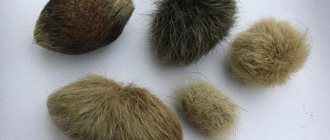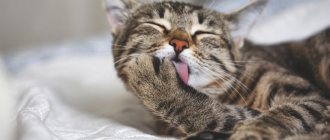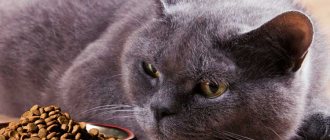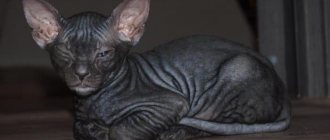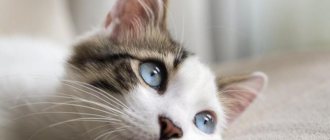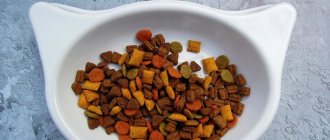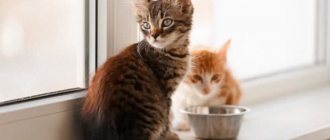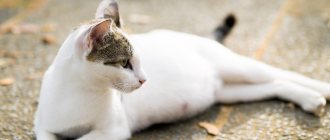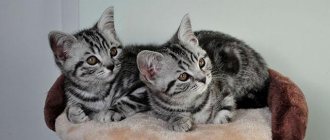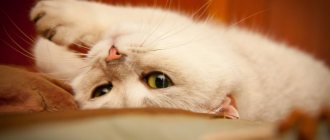Cats are decorations for any home. Graceful, purring and loving pets: what could be better? They are affectionate, beautiful, and it is impossible to take your eyes off their magnificent fur coat. But it is the cat’s fur that can cause many problems for its owner.
The fluffier the cat, the more hairs she sheds daily. This is an absolutely normal phenomenon associated with the life of an animal. However, this harmless process can cause a number of difficulties. The most common of these is the accumulation of hairballs in the animal’s stomach.
The dangers of hairballs in the stomach
Due to the peculiarities of the anatomical structure of the tongue (it is covered with small sharp papillae directed into the larynx), the cat cannot spit out dead guard hairs, so the hair inevitably ends up in the stomach. Due to the inability to be digested by gastric juice, it forms dense balls (trichobezoars) and clogs the gastrointestinal tract. Veterinarians call this phenomenon “gastric trichobezoar.” If not treated promptly, it can lead to the following complications:
- anorexia due to a false feeling of satiety;
- obstruction of the small intestine;
- constipation;
- disruption of the digestive process;
- pain in the gastrointestinal tract;
- ingrowth of villi into the mucous tissues of the oral cavity;
- inflammatory processes.
Due to the presence of trichobezoars in the stomach, the cat experiences constant discomfort. She will independently try to free herself from the foreign body by vomiting, but due to severe blockage, only liquid will come out. If you do not help your pet in time, surgical intervention is inevitable.
It is noteworthy that indoor cats do not have problems with the formation of trichobezoars in the stomach, since they lead an active lifestyle and have the opportunity to eat fresh grass, which improves the transit of fur through the gastrointestinal tract.
Gastric trichobezoars are most susceptible to:
- long-haired cats (Maine Coon, Persian, Siberian, etc.);
- older cats;
- animals that are obese or lead a sedentary lifestyle;
- cats with any type of coat (with the exception of hairless sphinxes, bambinos, elves, etc.) during the molting period.
Long-haired cats are most susceptible to gastric trichobezoar.
Personally, for the purpose of prevention, I always give my cat special homemade grass (it is sold in pet stores). It is a natural remedy for cleansing, contains minerals, amino acids, B vitamins, which not only improve digestion, but also have a beneficial effect on the appearance of the pet.
Wheat germ is the best remedy for preventing the formation of hairballs
External signs of hair problems in cats
The ideal cat's fur is smooth and shiny. A healthy cat devotes the lion's share of its time to grooming itself, licking its fur. If a pet suddenly neglects “personal hygiene”, its fur becomes dull, brittle and tangled, this is a sure sign of health problems.
- Dull fur.
This symptom can appear with diseases of the intestines and liver. However, it may also be due to an incorrect diet: if the cat does not receive enough fatty acids and vitamins or, on the contrary, receives too much vitamin A, this will affect the condition of its coat. - Hair loss.
All cats shed, this process is especially pronounced in autumn and spring. But if the hair begins to fall out in clumps, leaving bald spots, this is an alarming sign. There may also be a lack of vitamins. In any case, you should urgently seek the advice of a veterinarian. - Tangles.
They talk either about problems with the skin (too much sebum is formed or, on the contrary, excessive dryness is noted), or about the presence of parasites, or about an incorrect diet with a deficiency of vitamins. - Skin problems.
Itching and eczema in the absence of parasites and fungi can be a sign of mineral or vitamin deficiency, allergies and problems with internal organs.
When should you give your cat hair-removing food?
The following symptoms indicate the presence of hairballs in your pet's stomach at an early stage:
- anxiety, nervous excitement;
- mucus in undigested food or stool;
- nausea, vomiting;
- constipation or diarrhea;
- dry cough;
- the coat becomes oily and dull.
In the case of severe blockage of the gastrointestinal tract, the cat experiences frequent vomiting (without hair, but with blood), a complete absence of stool for a long time (despite the animal’s unsuccessful attempts to relieve itself), as well as refusal to eat. At the same time, it cannot be said that the pet has no appetite: on the contrary, he begs for food, but cannot handle even the minimum portion. This is due to the fact that the cat does not receive the required amount of nutrients due to a feeling of false satiety. If such symptoms are present, the owner must urgently begin treatment.
Rules of use
Special food for hair removal is enriched with essential vitamins and minerals, has the correct BJU ratio, and is therefore complete. If symptoms occur that indicate the presence of trichobezoars in the stomach, the cat must be completely switched to “medicinal” food and fed until the problem disappears.
Before use, be sure to read the information on the packaging: the manufacturer gives clear instructions and recommendations. The average daily intake is 15–20 grams per 1 kg of animal weight. If desired, the portion can be increased (the cat can eat as much as it is used to). Usually the course lasts about a month. The first positive changes are observed within the first week. For preventive purposes, food can be given 1-2 times a month.
My cat, although he ate store-bought canned cat food, flatly refused special food. It was possible to remove the hairballs with the help of a cleansing paste, which he absorbed with particular pleasure. Each pet's tastes are individual, so the owner will have to find a suitable remedy through trial and error. If the cat refuses to eat one food, I recommend trying to purchase 1-2 more products from different manufacturers. Surely there will be food from them that the fluffy will like.
References
- Panfilova, E.A., Isaeva, M.P., Troshina, E.A. Hypothyroidism: lecture for primary care physicians. Medical Council, 2021. - No. 11. - P. 124-130.
- Fayzullina, R.A., Zakirova, A.M. The importance of vitamin-mineral complexes in pediatrics. Bulletin of modern clinical medicine, 2016. - No. 2. - P. 97-103.
- Federal clinical guidelines for the diagnosis and treatment of iron deficiency anemia, 2015. - 16 p.
- Dayan, C. Interpretation of thyroid function tests. Lancet, 2001. - Vol. 357(9256). - P. 619-24.
Product composition
Hair removers contain several types of insoluble fiber that soften lumps and accelerate their transit through the gastrointestinal tract. Natural plant components (plantain seeds, flax) and oils envelop the walls of the stomach (serve as something like a lubricant), which allows trichobezoars to freely leave the pet’s body. The presence of vitamins and minerals helps normalize digestion and has a beneficial effect on the quality of the coat: it becomes shiny, smooth, and does not shed as much.
Hair-reducing food is suitable for animals that mainly eat ready-made store-bought products (canned food for cats, dry and wet food, etc.). Such cats practically do not feel the difference between new and old food, and therefore calmly accept “medicinal” food. This option is not suitable for pets whose diet consists of natural products. To remove hair, it is recommended to give them special cleaning pastes (Beafar, Cliny, Gimpet Malt-Soft Extra, Beafar). The principle of action and composition of such products are similar to hair removal feeds.
Ontario
Another representative of Czech production, whose assortment includes dry and wet rations. In the Ontario line you can choose food for:
- kittens, pregnant and lactating cats;
- adult animals;
- neutered pets;
- older animals.
The main source of protein in Ontario products is meat ingredients; there is no vegetable protein. Among the standard components for the premium class are also brewer's yeast, dried apples, a vitamin complex, and Yucca Schidigera extract.
However, the manufacturer indicates the sources of many product components only in general terms (for example, chicken products, poultry fat, antioxidants approved in the EU). Another disadvantage may be the pronounced smell of dry granules.
A two-kilogram package of Ontario dry food will cost from 650 rubles. As a supplement to the diet, you can choose canned food, of which there are 5 types in total.
Rating
It is worth paying attention to the most popular products from well-known manufacturers.
- Royal Canin Indoor Long Hair. This food is preferred by everyone who cares for their pet. It contains plantain seeds, and also helps remove hair from the stomach and improve the gastrointestinal tract. Borage oil is an element included in the product. It helps maintain the tone of the circulatory system, so that the hair follicles receive nutrients. The cat's fur looks great no matter how old she is.
- Fitmin Cat For Life Hairball. This food is suitable for adult cats with long hair, but it should not be fed to kittens. The product contains pork liver, poultry, eggs, animal fat, bran, flaxseed and so on. The products of the Czech brand are safe to feed your pets, since the food does not contain GMO products. After eating the food, your cat's fur will become healthy and soft.
- Schesir Hairball is a line of dry food for dogs and cats. It will be appreciated by those with long hair - Persian cats, Maine Coons, and so on. There are no preservatives or dyes in these foods, but the product is based on 100% natural ingredients - meat and fish that humans eat.
- Royal Canin Hair & Skin is a professional, balanced food. The effect can be noticed after a month - the cat’s fur becomes smooth and beautiful. Cats eat this food with pleasure, and their coat noticeably improves. Dry food contains Omega-3 and Omega-6 fatty acids. They are needed to maintain the protective function of the skin. High-quality food for your beloved pet will make the cat healthier and give its coat shine.
When choosing food for your beloved cat, do not forget to take into account all the nuances: age, coat condition and health of the animal. If you are in doubt about the choice of product, it is better to consult your veterinarian. When choosing food yourself, always read reviews and be careful, because we are talking about the health of your furry friend.
To see what food your veterinarian recommends for your cat, watch the following video.
Errors in selection
Each cat is individual, so it is better to show it to the veterinarian periodically. By showing your pet to the doctor, he will be able to tell you exactly which product is suitable for him. There is quite a variety of cat food, so it’s easy to make a wrong choice. You need to select a product based on age, activity and coat type. If you give your cat professional food, it is undesirable to feed the animal additional vitamins, as this can cause an overdose and the hair will begin to fall out.
Sometimes there is no need to panic because of bad fur - in some cases, you just need to wash the cat with a good shampoo, and then use a spray to remove the faded fur. When feeding a cat, it is not advisable to mix natural food with food. Such mixing harms the animal's digestion. With frequent changes in the type of feeding, the stomach does not have time to adapt, so the work of the digestive system becomes more complicated.
When you change your diet, a number of problems appear - coprostasis, gastroenteritis and other dangerous conditions. In addition, mixing introduces an imbalance into the body.
